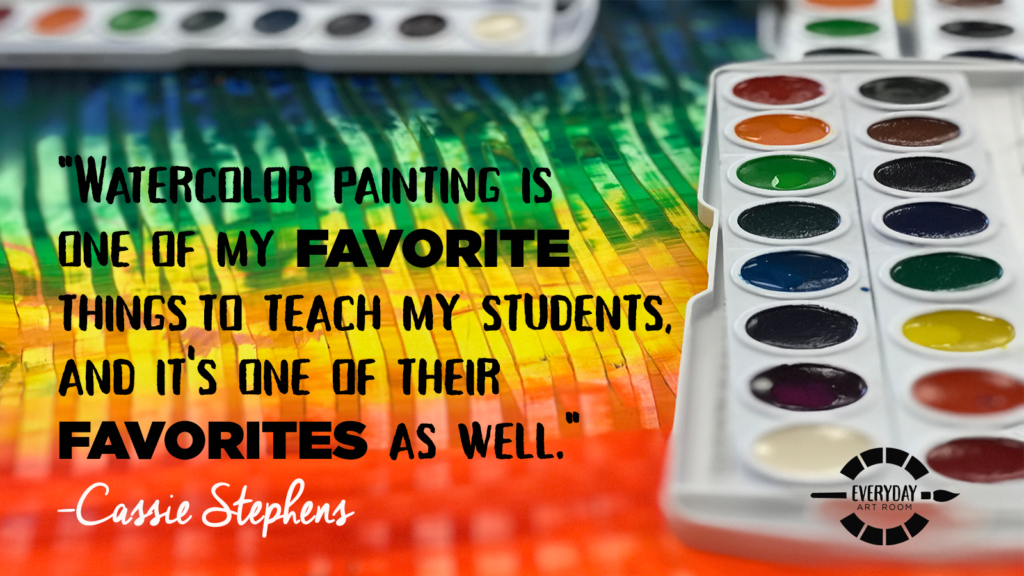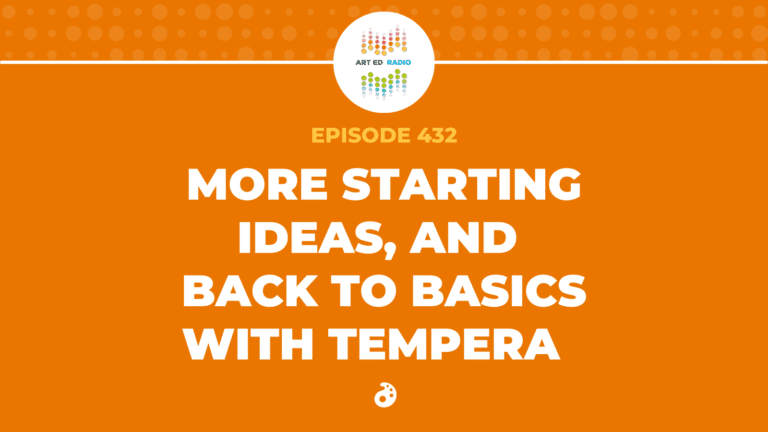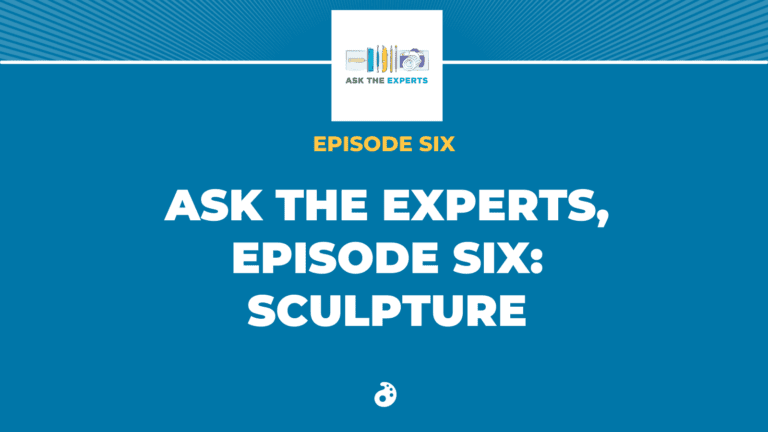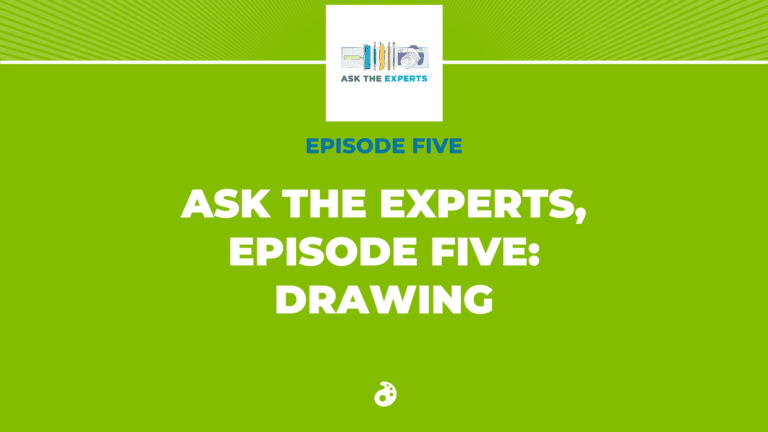Watercolor painting isn’t always the easiest thing to pull off with elementary kiddos, but they love the experience so much that it’s almost always worth it. In this episode, Cassie talks you through the ins and outs of what watercolor painting looks like in her classroom. She also shares some tips about how you can make it work for you and your students. Listen as she talks about budget and supplies (4:45), what she calls “The Danger Zone” (10:45), and how to establish a successful cleanup routine (15:00). Full episode transcript below.
Resources and Links:
- Check out this awesome watercolor lesson from Cassie’s blog
- 7 Simple Watercolor Techniques
- If you’re an Art Ed PRO member, check out the “Getting Started with Watercolor Painting” Learning Pack!

Transcript
The other day I had my dear, sweet and amazing second graders in my room. These kids are the best. I’m just going to brag on them. I love them so. However, they sometimes appear to have a very selective memory. Case in point, I know for a fact that we have talked about the artiste Vincent van Gogh, but they acted like I was speaking Martian and had absolutely no clue what I was talking about. After re-explaining the artist one more time, I then dived into the watercolor portion of our project. I started to remind them of all the different techniques that we used and just about how we care for our brush.
It was just when I was demonstrating to them how to wash and dry off their brush, I heard at least a group of three of them simultaneously start singing the song I taught them two years ago in kindergarten when “Whip Nay Nay” was popular. I dipped my brush, and I swear they must’ve counted down from three. All of them started saying, “First I dip, and then I wipe, wipe and then I dip, dip, and I wipe, wipe.” Then the entire group started to erupt, “Watch me, watch me.” Okay, like you can’t remember who painted Starry Night, but you can remember that? Ah, yes. The joys of teaching second grade, and also let’s talk today about the joys of watercolor painting with kids.
Y’all, this is to be at the bottom of my list of things to teach my students but now, watercolor painting is one of my favorite things to teach my students and one of their favorite things to do. Let’s talk about how I went from being a hater of all things watercolor to a lover, not a fighter that doesn’t go with that. This is Cassie Stephens, and this is Everyday Art Room.
Now, if y’all listened to last weeks’ podcast, I shared with you the biggest lie I was ever told in college. That was a really fun podcast for me to share with you guys, and the reason I bring it up is because another fib I was told in college in my painting classes was this. I was led to believe that watercolor painting wasn’t real painting, and if you were painting with watercolor, then you weren’t making real art. What were these people trying to instill in very vulnerable little brain? I don’t know, but it stuck with me and so I never really learned how to use watercolor paint. That’s the key to teaching elementary art. That’s art supply we all use at least once a month with our students, is watercolor paint.
So when I first started teaching art to my students, I didn’t love watercolor paint. I didn’t know how to teach them how to use watercolor paint correctly, and therefore when they did paint with it, they weren’t very successful and ended up not enjoying it as well either. Thankfully, I did a little bit of homework, did a little bit of experimenting of watercolor painting on my own, and I discovered, “You know what? This actually a really great supply to use with my students.” I know what you’re thinking. “Well, duh Stephens,” but I’m telling you, this is not something that I learned in college.
All the things that we wish we would have learned before entering the wild world of art teacherin’. Anyway, today I’m going to share with you how watercolor painting went from being my least favorite to one of my favorite art supplies to teach to my students. So let’s start though, first things first, with supplies because as it comes with all things art teachering, the art supplies are super important. When I first started ordering art supplies, I had a budget, like we all do. It was pretty tight, and I went the cheap route. I thought, “Why are there 25 different kinds of watercolor paint? Surely they’re all the same.” Don’t call me Surely.
They’re not, by the way, and the cheapo ones that I ordered were miserable, so it helps to do a little bit of homework. I know what watercolor paint I love so very much, and I’m going to share that with you. First of all, when I say watercolor paint, today I’m going to be chatting with you about pan watercolor, not liquid watercolor. I love liquid watercolor paint, but when it comes to liking one more over the other, when I paint with my students, I feel pan watercolor paint is better for them simply because they can actually see what colors they’re painting with and they can mix them a lot easier. I’ll get into more about liquid watercolor paint in a future podcast, but for now, I’m going to focus on pan.
When I order my pan watercolor paints, I simply order the refills. That’s right, in case you didn’t know because I didn’t for the longest time, you can just order the refills. They simply pop out of the pan, and I love to use Crayola’s mixing colors. This is not an endorsement. This is me speaking to you truthfully. This is what I love to order. I lay out my watercolor paints in the pan in rainbow order starting with magenta, even though I guess technically that’s not rainbow order. Magenta, red, red orange, yellow, green, turquoise, blue violet, and violet. Those are the only watercolor colors that I order when I’m placing my refill supply order.
I lay them out in that exact order in the pan. Then next step, what I order are brushes. Oh, paint brushes again. With me, the first couple of years, I’m going the cheap route and you get those paintbrushes that are losing more hair than my dad. These things, you spent more time just picking the loose hairs out of the kids paintings and out of the paintbrushes. Get good quality paintbrushes. Definitely splurge, and make sure you get a variety of sizes and brushes. Get the bristle brushes from when you’re using thick juicy tempera paint and then the soft sable brushes for when your students are watercolor painting.
Now, when it comes to watercolor paper, that I don’t order. Instead, I just generally order several reams, and by several I mean three, reams of 80 pound paper. I feel like 80 pound paper you can do just about anything on, and it does not have a really bad warp to it. Plus, it’s so much cheaper than watercolor paper so I forgo the watercolor paper and I just get the 80 pound good stuff. Then, when it comes down to water, I don’t splurge on this one. My favorite way to have water distributed to my students is using doggie dishes. There are these amazing doggie dishes that you can find at the Dollar Tree, and they have two compartments: one I’m assuming for food, the other for water.
In my room, we use one side for water obviously, and then the other side I have a sponge that’s been cut down to size to fit inside that side of the tray. The reason I love dog dishes so much is because they never spill. You can’t tip these things over. They’re amazing. Not only that, but they have just the right amount of water and they’re the perfect size to hold that sponge. Last, but not least, when it comes to watercolor painting, it helps to have something underneath while the kids are working for two reasons. One, it’ll make it so that they can easily transport their drippy masterpiece if they have a little tray or piece of paper underneath, and I always use a laminated sheet of paper for this reason.
Watercolor paint can sometimes, as you know, drip through the paper, and when it does, then that can get on a messy mat, if you have like a paper messy mat underneath. Sometimes I’ve even noticed that my messy mats are really messy with tempera paint. The tempera paint will then mix with the watercolor paint making a huge mess, so I love laminated pieces of construction paper to use as our watercolor “trays”. Then when my students are finished with their paintings, they can easily just carry that laminated piece of paper with their art work on it. Those are my supplies: paintbrushes, watercolor paint, doggie dishes with water and sponge, laminated place mat and 80 pound paper.
Then it comes to how to teach proper usage of watercolor paint, and this is time-consuming, but it’s an important thing to do to really make sure your students understand your expectations when it comes to painting. I’ve gotten the question a lot of, “How do you get your kids not to mix up the colors?” Guys, you’ve got to teach them. I’m telling you I thought the same thing when I first started teaching. I thought, “Man, what is wrong with these kids? Why are they grinding that brush into that poor watercolor tray? Why aren’t they adding more water to their paintbrush? They know that their paintbrush is dry.” Y’all, they don’t know. Assume they know nothing.
If I were going to go into a PE class and they were playing volleyball, I would not have a clue. I would be ducking and dodging. A PE teacher would have to assume I would know nothing because I don’t. You need to do the same when teaching your students anything, no matter what age. It may feel redundant or silly for you to tell them these things, but it’s not, especially kids these days with all the technology they use. They don’t have as much experience with art supplies as you may have when you were growing up.
All right, so let’s talk about how to teach proper usage. The first thing I always start with is the paintbrush, and I explain to the kids the different parts of the paintbrush. I tell them that the handle is called the handle because that’s where your hands go, and then from there is the ferrule. I tell them that inside the ferrule are two things: the handle and the bristles of the brush. We also refer to the ferrule as the danger zone. They love this. If you tell them that that gold or silver shiny ferrule is the danger zone, and that their fingers are in danger of getting dirty if they enter the danger zone … Okay, I’ll stop, you get the point. Then, they know to keep their fingers behind the ferrule and not have their hands bunched all the way up, down toward the bristles of the brush. So that’s just another way also to help them keep their hands from getting too messy.
Last, but not least, we talk about the bristles of the paintbrush, which as you know are your paintbrushes hair. Then I go into quite a bit of detail. I tell them that your paintbrush is like a ballerina. She always dances on her tippy toes, and that’s when I’m referring now to the bristles of the brush, and I show them just how nice and pointed the watercolor bristles of a brush should always be. We say that our paintbrush ballerina should always have pointy toes. She should never have parts of her toes all spread out. You know what it looks like when the kids grind the brushes into the paint or at the bottom of the water cup. I tell them that that is what is called the booty-scooting ballet, and don’t nobody want to go to the booty-scooting ballet, so it’s super important that they always remember to keep those tiptoe ballerina toes nice and pointed.
All right. Now, let’s talk about how they’re going to get started with painting. Once all the parts of the brush are explained, I tell them that with watercolor paint the reason it’s called watercolor paint is because you must add water. We talk about how to tap little droplets of water into the watercolor paint pan. We call this waking up the paint, and as silly as this may sound, I literally will tap every little oval of color and tell it to wake up. I’ll say, “Time to wake up red paint,” and red paint will say, “Uh, I don’t want to get up.” “Come on orange, time to wake up.”
“Yes, Ms. Stephens, I’m ready to paint.” “Hello yellow. Time to get up.” “No, I’m asleeping.” They manage to have similar accents this. This, I know. I’m working on it, but like I always say, silly sticks. The sillier you make this, just like the Whip Nay Nay, the more they’re going to retain it, remember it, and remind each other to do it. Once I’ve gotten all of the paint woken up, we talk about how to get different values with watercolor. I explain to them that with watercolor you have to always dip your brush in water first before getting your color. The longer your paintbrush ballerina twirls in that pan of paint, the darker value of color she’ll be able to get.
If she only twirls a little bit, it’s going to be a very light value. If it twirls a little longer, it will get darker and darker. Then we talk about how to switch colors, and this is so super important. Y’all have seen your friends, and by friends I mean your students, dip from one color to the other color contaminating the whole tray, managing to make the whole thing mud, or as we call it do-do brown. We don’t want that, so I am a stickler on the very first days of painting. When my students go to their seat, I watch them like a hawk, making sure that they always remember to clean their brush before getting a different color. It’s so important to establish that early on.
I’m not going to lie, I have asked kids to go take a little chill out break on the floor if I see them mixing up those colors. Trust me, when they go back to their seats, they remember to wash their brush in between. So let’s talk about that. I said I have the doggie dish and the sponge. I tell them not to dip their brush over and over again in the water because what that will do is splash dirty paint water onto their masterpiece or their neighbors. So instead, I tell them to put their brush down to the bottom of the cup and gently scrub. When I do this as a demonstration, it sounds like a little scratching sound. We call it the brush is brushing its teeth.
From there, we wipe on the sponge, which we refer to as dirty old SpongeBob. I’m telling you, they won’t forget that. Then we dip in water again to rehydrate, rehydrate the brush. That helps them remember that they need to grab more water and then get their different color, or you can always do the Whip Nay Nay song, although that one is now a little bit passé, but trust me, they’ll remember it if you do. Then from there, as I begin to demonstrate painting, I just remind them that as they paint, their ballerina paintbrush should always glide over their surface. She should always be dancing smoothly across. This is something else that as my students are working at their seat, I definitely walk around the room and monitor.
The reason this is so important is this. You’ve seen your students painting with watercolor paint and as their brush gets a little bit dry, they start to scratch and scrub that brush into the surface of their paper. I tell them that when their paintbrush starts to get a little dry or make dry and scratchy brush marks on their paper that it’s their paintbrushes way of telling them that they’re thirsty and that they need more paint and they need more water. So as they’re painting at their seats, when I see some dry brush happening, and it’s not the look we’re going for, I gently remind them that that’s their paintbrushes way of telling them that they’re thirsty and they need more water.
So with all of those things, that is how I chat with my students on the front end, a lot of talking, I know, about painting with watercolor paint. The beauty of watercolor paint, and another reason that I love it so, is because not only do they produce beautiful paintings but the cleanup is so easy. In fact, I always request that with watercolor paint that the kids clean the brushes at their seats, wipe them off on dirty old Sponge Bob and return them toes up back at the store. Then I don’t have to wash 20-some paintbrushes. How awesome is that? When it comes to putting away the paintings, unfortunately my drying rack has a little bit of an angle to it, which when watercolor paintings are placed on there can cause the watercolor paint to drip.
So with that in mind, my students simply leave their watercolor masterpieces on the laminated paper and carry them to the floor where we just line them up along the wall. There you have it. My least favorite thing, at one point in time, to introduce to my students is now one of my favorites. Thank you so much for letting me share my watercolor tips and tricks with you, but don’t you worry, we will be chatting about other kinds of paint and how I go about having my students use them in my room. Soon.
Tim Bogatz: I hope you’re enjoying this episode of Everyday Art Room. If you’re looking to learn even more about watercolor painting, I want to suggest you check out Art Ed PRO. Earlier this month, we released a new learning pack called Getting Started With Watercolor Painting. This learning pack has 20 videos and 13 downloadable and printable resources that show you everything you need to know about teaching watercolor painting in your classroom. You will learn strategies, techniques, organization, management and how to weave all of these ideas seamlessly into your curriculum. Getting started with watercolor is just one of the 45 learning packs in the PRO library dealing with a huge variety of topics that can help you in your classroom. Check it out and start your 30-day free trial at theartofed.com/pro. Now let’s go ahead and finish out the episode.
Cassie Stephens: Now it’s time to take a little dip into the mailbag. This question comes from Stephanie. She asks, “My classroom doesn’t have a working sink so I’m struggling to find the right flow to have the kids clean up. Right now I have a system that’s pretty chaotic, but I’m seeing if there’s a simpler way to have them clean up their supplies and their area. Also, do you any advice about pallets? Right now, we are having to use paper plates and I hate how wasteful it is. Without a working sink, I’m not sure what is the best way to go about pallets for students when I don’t have enough time to wash them all and I don’t have a working sink.”
Well, I’ll tell you this Stephanie. I taught sinkless for several years in my portable trailer that I taught in. Actually, it did have a sink, a very small one. It just didn’t work very often, so I can totally feel your pain. Here’s what I did. I keep, and I’m talking tempera paint because I have a feeling that’s what Stephanie is chatting about as well, I keep my tempera paint in ice cube trays. You can find ice cube trays, a set of three at the Dollar Tree, my favorite place. I use those to distribute paint, so I simply fill up the trays with the colors that my students will be using.
At the end of class, I cover the trays with plastic wrap and stack them up. If you want to get really, really airtight you can then place them in something like a grocery bag, a plastic grocery bag. I will warn you though, some paint I have noticed does have a tendency to mold if the paint is wrapped up for too many days, so that’s just something you might want to watch out for. Definitely not something you want to expose your students to. However, when my kids are finished painting using those ice cube trays, I simply lay them out to dry over a couple of days and then once dry, I just twist them and cracked them over the trashcan to get all of the dry crusty paint to fall out.
This is my exact same method for distributing clay, except when I crack the glaze out of the ice cube trays, I actually save those big chunks of glaze, dried glaze, and throw them back in my glaze containers. Now, I never, because I’m a hot mess and a slob, I never wash my ice cube trays. I simply crack them, dump out what’s able to come out of the ice cube tray into the trashcan, but I’m not going to be taking the time to scrub each one of those individual little trays clean. Heck no. Instead, I just pour more paint into it.
Another alternative to that would be to send out a school-wide email asking for egg cartons. Egg cartons are great for distributing paint, especially the styrofoam or the plastic ones. The paper ones, not so much as they tend to absorb the color of the paint and dry the paint out a lot faster. Now, when I want my students to change colors, if they’re painting with tempera paint, since you don’t have a place for them to get cups of water for washing their brush, I do this a couple of different ways. I used to give them paper towel and do something called pinch and pull. I would tell them that when they wanted to change colors on their painting, they would have to take their paintbrush and wrap the paper towel around it, pinch it to squeeze all the paint out, and pull the brush out.
I told them that they should probably do that two times just to make sure they were able to pinch and pull the paint out before getting another color. That did create some waste, especially when it came to paper towel, but it did also make it so I didn’t have to get water for my students. Another method is to have tag board place mats where your students are painting. Tag board can be found in your art supply catalogs. I purchase it at the size of 18 x 24 inches so it’s a large place mat for your students. We refer to them as our messy mats. So instead of having your students pinch and pull their paintbrush, they could simply sweep their paintbrush back and forth on the messy mat to clean it, and that usually does the trick as well.
Now, if you don’t have a sink when it comes to handwashing, I have three sinks and I still don’t really allot time in my art class for all 20 to sometimes 30 to sometimes more students to go to the sink. I just don’t. My whole rule is, “Hey, it’s art class. We’re supposed to get a little messy. If you didn’t get messy, then you weren’t doing your job.” However, there are times when I have students who are excessively messy and for that you might want to keep some baby wipes on hand. You could also send out another school-wide email requesting those, or perhaps put it on your parent wish list. My rule with baby wipes is you can only get one and you have to clean two things with it: your hands and the spot where you were working. Stephanie, great question and look at you, a great tie in since we were talking about painting this week. If you guys have any questions that you want to throw my way, please feel free to do so. You can find me at everydayartroom@theartofed.com.
Thank you so much for letting me share with you the joys of watercolor painting. It truly was not one of my favorite things to do or teach my students, and yet now, it is. It really all does come down to not only giving your students the very best supplies that you’ve really decided work well for them and your budget, let’s be honest, but it also comes down to showing them the proper way to use those supplies. Once you’ve really spent the time to teach them how to use these art supplies correctly, and remember silly sticks, they will remember it, you’ll be so thrilled with the results. I know I am. What’s even better, I know that they are. Thanks again for joining me, guys, and I hope you have a fabulous week. This is Everyday Art Room, and I’m Cassie Stephens.
Magazine articles and podcasts are opinions of professional education contributors and do not necessarily represent the position of the Art of Education University (AOEU) or its academic offerings. Contributors use terms in the way they are most often talked about in the scope of their educational experiences.



